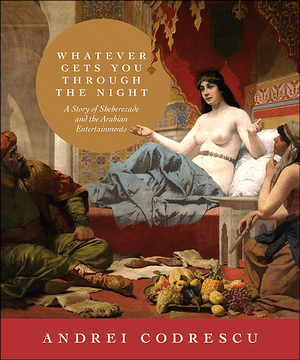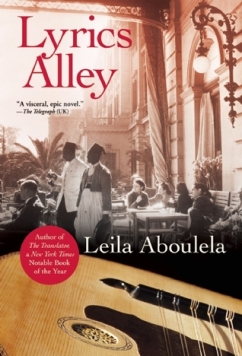Arabian Nights and Days: A Novel by Naguib Mahfouz, trans. by Denys Johnson-Davies, Doubleday, 1995. (Originally published 1979 in Arabic)
Whatever Gets You Through the Night: A Story of Sheherezade and the Arabian Entertainments by Andrei Codrescu, Princeton University Press, 2011.
“Shéhérezade” (ballet, 1910), choreography by Mikhail Fokine, The Kirov Celebrates Nijinsky [DVD], Kultur, 2002.
Rimsky-Korsakov: Scheherazade/ Russian Easter Overture [CD]. The Atlanta Symphony Orchestra, Robert Spano, conducting. Telarc, 2001.
In my previous post, reviewing Marina Warner’s exciting new work of cultural criticism, Stranger Magic, I promised to discuss a few examples of retellings that continue to expand Scheherazade’s legacy. The corpus of such retellings and variations is truly a measureless “sea of stories,” to borrow a bit of the title from Salman Rushdie’s Haroun and the Sea of Stories, an illustrious example of this genre of storytelling art. One reader of my review of Warner, Ray Wilcockson, cited Robert Louis Stevenson’s New Arabian Nights (1882), a collection of Stevenson’s earliest stories that flowed from his own excitement over reading the Arabian Nights and which adapted its connected structure for his own modern tales. Warner mentions Stevenson, along with many other writers whose work has been prompted and inspired by the Arabian Nights. She recommends Robert Irwin’s excellent survey of such works in his chapter, “Children of the Nights” (in his book, The Arabian Nights: A Companion).
I will write about two books, Arabian Nights and Days by Naguib Mahfouz and Whatever Gets You Through the Night by Andrei Codrescu. These two caught my attention because of their focus on Scheherazade herself and their further exploration of the frame story of The Arabian Nights. I will also consider the most famous musical exposition of the character of Scheherazade, Rimsky-Korskov’s (1888) symphonic suite, and how the ballet later choreographed to that music diverged from the composer’s conception.

The Egyptian writer Naguib Mahfouz, the 1988 Nobelist in literature, is probably best known for his Cairo Trilogy (in Arabic; published in English with the titles Palace Walk, Palace of Desire, and Sugar Street). I was delighted to read his later novel Arabian Nights and Days, which is a sophisticated retelling of the Nights’ frame story and some of its important tales. Mahfouz refashions the stories to bring new insight into the characters of Shahrzad and Shahriyar (as they are spelled in Denys Johnson-Davies’ spare, yet mellifluous translation); they must truly grapple with the implications of all that gone before the moment when Shahrzad’s storytelling begins. Mahfouz connects each tale to the one that follows with seamless logic and suspense, and he brings greater depth even to such figures as Ma’rouf the Cobbler, Ugr the Barber, and, of course, Aladdin and Sindbad. But for me, the most arresting moment came when he implicitly asked the novelistic question, how would Shahrzad feel when she achieved her “victory” over the Sultan? His examination of this question plumbs new depths latent in one of the most well-known stories in world literature.
Before we see Shahrzad, Mahfouz shows us her father, the sultan’s vizier Dandan. In the three years that his daughter has been suspending Shahriyar’s death sentence with her entrancing stories, the vizier’s anxiety has not been suspended–quite the opposite. Each morning he would go to the palace, waiting to discover if this dawn would be Shahrzad’s last. On this day, “the heart of a father quaked within him” because he knew Shahrzad had done the unthinkable–she had ended her tale and her own fate must be decided one way or the other.
Dandan found Shahriyar alone, contemplating the first hints of sunrise: he says,”It is our wish that Shahrzad remain our wife. …Her stories are white magic…They open up worlds that invite reflection” (p. 2). When the Sultan continues, announcing that Shahrazad gave him a son and brought peace to his “troubled spirits,” the vizier wishes him happiness now and in the hereafter. This innocent blessing triggers a biting response–the Sultan dismisses the notion of happiness and puzzles over existence itself. In this way, we are given the first hint that although death is forestalled, “happily ever after” may not come as easily.
Next the vizier seeks out his daughter. Her response to her reprieve is complex and profound, even though it unfolds in a brief exchange that barely takes up two pages. Shahrzad acknowledges that by “the Lord’s mercy” her life has been spared and the young women of the city–those remaining–are no longer in peril, but at the cost of her happiness: “’I sacrificed myself,’ she said sorrowfully, ‘in order to stem the torrent of blood’” (p. 3). The vizier protests that the Sultan now loves her and that love works miracles, but Shahrzad answers that, “Arrogance and love do not come together in one heart” and, most devastating of all, “Whenever he approaches me I breathe the smell of blood” (p. 4).
Mahfouz has seemingly told the end at the beginning, but is it really the end? As his brilliantly refashioned cycle of tales nears its conclusion, Shahriyar becomes prominent again as the auditor of Sindbad’s tales of his voyages, told by Sindbad himself as fables of the wisdom he won along the way. Shahriyar persistently queries him as if his (Shahriyar’s) life depended on the answers. Sindbad finishes and Shahriyar retreats to his lush flower garden, pacing and remembering, his mind in turmoil and his heart gripped by weariness and disgust at his life–at the follies of life itself. He summons Shahrzad for a new dialogue–one not known to the ancient tradition but equally fateful, and full of truths as ancient as humanity. He confesses his need for repentance and reveals that he has known all along of her that “your body approaches while your heart turns away.” In a masterful stroke, Mahfouz’s Shahriyar asserts that he kept Shahrzad close to him as a reproach–“I found in your aversion a continued torment that I deserved” (p. 217). Shahrzad weeps, her heart melting perhaps for the first time in his presence, and he sees at once that this weeping means more than all the pretense of her love up to that point. He vows to renounce his kingdom and wander in search of wisdom and meaning, leaving his son, with Shahrzad’s counsel, to rule more wisely than he did. Now it is Shahrzad’s turn to see the bitter irony of this sudden decision–“You are spurning me as my heart opens to you. …It is an opposing destiny that is mocking us” (p. 218).
I hope readers of this blog will forgive the “spoilers” I have felt necessary to include. I shall leave one last surprise unspoken–what Shahriyar discovers on his quest for truth. But I wanted to disclose this much to make clear what a tour de force this new resolution of the frame story represents. Mahfouz’s alternative frame story refuses to find Shahriyar’s healing at the point when he rescinds the order of execution. No, that will not be enough to cure a soul that has strayed so far. Shahrzad feels this in her own heart, but she has done all she can do. She carries the wounds of all the sacrificed wives who preceded her, and now she too is in need of healing. Only Shahriyar’s act of atonement1 can change the equation. And with amazing poignance, it is only at the moment when the Sultan decides to leave Shahrzad that their real love story begins.

NPR contributor and prolific writer Andrei Codrescu offers a retelling, Whatever Gets You Through the Night, that could hardly be more different from Mahfouz’s in tone and aims. Mahfouz is spare and restrained, recounting events and suggesting feelings and motivations with great economy. Codrescu is expansive (his Sheherezad doesn’t appear until page 46!), revelling in digression and comment, in voluminous marginal notes that can sometimes ring the main text in small type. In his ironic, punning treatment of the stories and in his commentary, he reveals his attitudes toward the gender politics of the stories as well as the whole historical enterprise of translating and transmitting the tales. Twenty-three different epigraphs, arranged together before the main text, quote sources ranging from Wikipedia to rival translators Richard Francis Burton and Husain Haddawy to critic J. Hillis Miller to the Rolling Stone, announcing that this retelling will be openly conscious of all the textual history that has gone before. A preface of sorts includes these observations on Sheherezade:
“We are bound to tell her story no matter what our postmodern wishes or rebellious inclinations might tell us: simply pronouncing her name invokes her. When she appears, like the Genie in the bottle of literature that she is, we must obey the order of her stories [he doesn’t]; this is the exact opposite of the Genii and Genies who are freed or imprisoned in the bottles of her characters, who must obey their liberators….” (p. 1)
This passage is characteristic of Codrescu and of the experience of reading this book: expect trenchant observations delivered with irreverence, skepticism, and a winking eye. Also expect the story will linger on lurid details of the murders of the Sultan’s previous wives and explicit description of the sexual situations implicit in the story. This text attempts to startle the reader into taking a fresh look at an old narrative tradition. Within that tradition, Codrescu aligns his sympathy more nearly with Burton, whose titillating translation, cloaked in archaic language, fed a certain late-Victorian appetite, especially his own.
Codrescu makes crucial archetypal connections between Scheherazade and figures such as Penelope and Ariadne, as in this brilliant synthesis:
“Sheherezade’s job was to be like Ariadne to make the King believe that she was showing him the way out of the labyrinth of his insecurity and cruelty, while weaving [like Penelope] at the same time a labyrinth from which he could never escape to kill again.” (p. 97)
The net that is woven is an erotic one, but oddly Sheherezade herself is sidelined in favor of her sister, Dinarzad. The storytelling ménage à trois becomes a sexual pas de deux between the two listeners, Sharyar and Dinarzad, whose dalliance fails to reach its climax just as each story’s ending is postponed.
Codrescu offers what he calls the “unpopular” ending, one in which he posits there was no baby, no reconciliation of the Sultan to women, and, therefore, no pardon for his Sheherezade; he prefers to believe that the stories had no end and we can listen in whenever we choose. In fact we need to listen, trancelike, he argues, because we cannot face our lives without entertainment. Thus, he concludes with an extended meditation on media culture where we are “angry mass-Sharyars” and “terrified when you are silent” (p. 173). All of this does end up being intriguing and a very modern deconstructive performance, but I confess that I preferred Mahfouz’s Arabian Nights and Days, which explored more deeply the redemptive core of the Nights, while preserving the echoes of the imaginative realms that gave it birth.

I was going to write at length about Rimsky-Korsakov’s gorgeously melodic symphonic suite of Scheherazade and compare it with Mikhail Fokine’s popular Scheherazade ballet of 1910, set to some of its music, and with a new libretto by Léon Bakst and Fokine. (Rimsky-Korsakov’s widow was apparently quite unhappy with the rearrangement of the score.) Despite its name, the ballet dramatizes only events occurring before the intervention of Scheherazade, namely, the infidelity of the Sultan’s first wife. Most of the dancing is a sensuous, extended duet between Zobeide2 (the wife) and a “Golden Slave”–in Fokine’s Ballet Russes choreography, this role was a vehicle for the superlative genius of Vaslav Nijinsky.

Unfortunately, Scheherazade’s recurring narration from bed does not lend itself easily to having her dance! Ahh, but I see the night grows short, this post is already very long, and I must stop for now and send you to meet the musical Scheherazade for yourself in the lyrical space beyond words…
Notes:
- In this connection, I highly recommend Phil Cousineau’s Beyond Forgiveness: Reflections on Atonement (Jossey-Bass, 2011), which collects essays from diverse authors on ways to move from words of repentance or forgiveness toward atoning actions which may potentially heal both parties.
- I recommend a performance of Fokine’s ballet in The Kirov Celebrates Nijinsky (DVD), but be aware that the back-cover text incorrectly identifies the principal female role (danced by Svetlana Zakharova) as Shehérézade instead of Zobeide.
Related post:
Tags: 1001 Nights, Adaptations, Andrei Codrescu, Arabian Nights, Ballet, Classical Music, Fokine, Forgiveness and Atonement, Naguib Mahfouz, Nijinsky, Pastiches, Phil Cousineau, Rimsky-Korsakov, Scheherazade, The Fictional 100
 Leila Aboulela (b. 1964) was born in Cairo, Egypt but spent her first 23 years living with her parents in Khartoum, Sudan where she received her education, first at the Khartoum American Academy, then at a private Catholic high school, and at the University of Khartoum, with a degree in economics. She also took an MPhil degree in statistics at the London School of Economics. Notwithstanding these impressive mathematical credentials, her literary gifts are even more impressive. She has won or been short-listed for numerous national and international writing prizes. She won the first Caine Prize for African Writing for her short story, “Museum,” which appears in her collection Coloured Lights (2005). She writes in English. Although she was educated at a Catholic High School, she is a devout Muslim and often writes about the Muslim immigrant experience. In 1990 she moved to Aberdeen, Scotland, and this was the setting for her first novel, The Translator (1999), the story of a Sudanese widow who translates for an Islamic scholar at a Scottish University.
Leila Aboulela (b. 1964) was born in Cairo, Egypt but spent her first 23 years living with her parents in Khartoum, Sudan where she received her education, first at the Khartoum American Academy, then at a private Catholic high school, and at the University of Khartoum, with a degree in economics. She also took an MPhil degree in statistics at the London School of Economics. Notwithstanding these impressive mathematical credentials, her literary gifts are even more impressive. She has won or been short-listed for numerous national and international writing prizes. She won the first Caine Prize for African Writing for her short story, “Museum,” which appears in her collection Coloured Lights (2005). She writes in English. Although she was educated at a Catholic High School, she is a devout Muslim and often writes about the Muslim immigrant experience. In 1990 she moved to Aberdeen, Scotland, and this was the setting for her first novel, The Translator (1999), the story of a Sudanese widow who translates for an Islamic scholar at a Scottish University.
 Naguib Mahfouz is probably the best known North African writer worldwide. This is especially true since 1988 when he was recognized by the Nobel Prize for Literature. Here is how M. A. Orthofer describes him in his wonderful book, The Complete Review Guide to Contemporary World Fiction:
Naguib Mahfouz is probably the best known North African writer worldwide. This is especially true since 1988 when he was recognized by the Nobel Prize for Literature. Here is how M. A. Orthofer describes him in his wonderful book, The Complete Review Guide to Contemporary World Fiction:

























Recent Comments